Recording a historical event in the heart of the Torah-oriented chasidic city of Bnei Brak
Twenty-five ambassadors of European Union member countries participated in an event to mark Yom HaShoah, hosted by Ganzach Kiddush Hashem in Bnei Brak.
The highly impressive meeting was carried out at the request of the EU Ambassador to Israel, Mr. Dimiter Tzantchev, and holds historical significance for the fight against antisemitism; Ganzach Kiddush Hashem held the program in order to leave a strong impression on the participants and the countries that they represent.
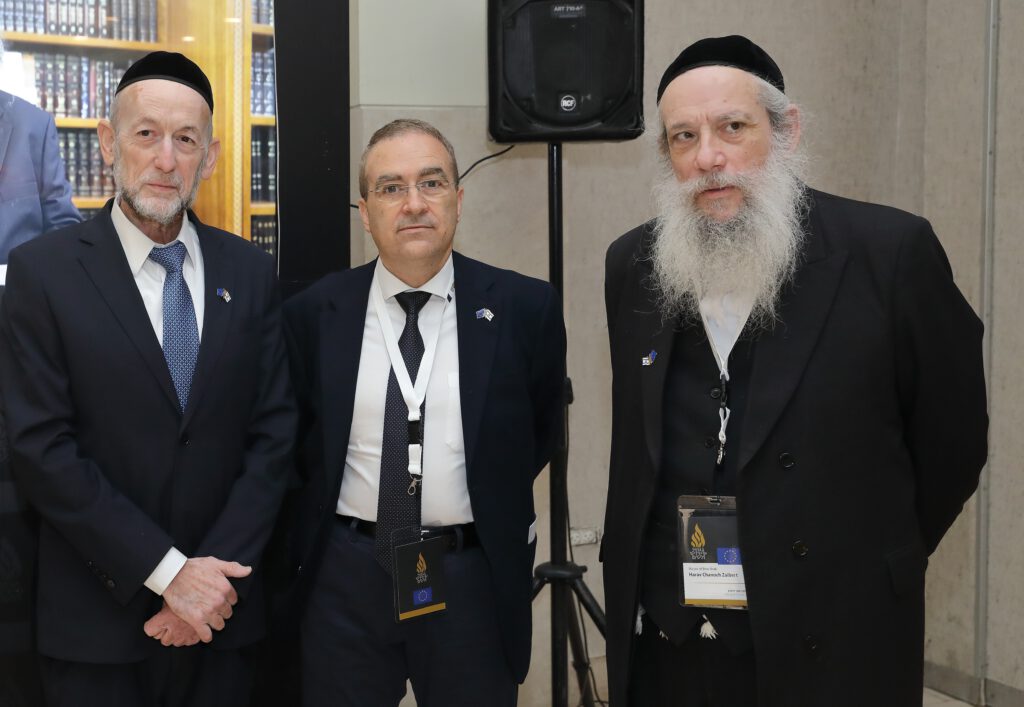
Ambassador of the EU, Dimiter Tzantchev, with Bnei Brak mayor, Rabbi Hanoch Zeibert, and Member of Knesset and head of the Authority for Holocaust Survivors, Rabbi Uri Maklev
As part of the daily activities of Ganzach Kiddush Hashem, a long-standing and respected Holocaust commemoration institution, we welcome public figures from Israel and the world at large who seek to see and become acquainted with the heroism of the pure Jewish spirit, which Ganzach Kiddush Hashem has been working on for decades to perpetuate and preserve the memory of. However, this event was unique and rare, since the visit of the ambassadors of 25 European countries at the same time to an ultra-Orthodox institution in the middle of Bnei Brak evokes a huge response, and it will be of great benefit to all of Israel and the world. The European ambassadors saw, heard, and read content that they previously had never been exposed to.
Specifically in Bnei Brak
The European ambassadors requested to be hosted specifically in Bnei Brak for the conclusion of the Yom HaShoah events, and rightly so, since Bnei Brak has since been a home for thousands of Holocaust survivors who rebuilt their lives there, and Bnei Brak, to a large extent, portrays what was “there” (prewar) and was destroyed to its core .
The walls of the synagogues in Bnei Brak are lined with countless plaques commemorating the Holocaust victims, which were installed by their relatives, the residents of Bnei Brak who rose from the ashes and built new worlds.
To a large extent, the landscapes of Bnei Brak, the small and calm city of old, have changed. Bnei Brak is no longer planted with orchards or strewn with flowers in the courtyards of houses. And, unfortunately and longingly, in this crowded and noisy city, the figures of thousands of Jews from Poland, Hungary, Romania, Germany, the Netherlands and other European countries, the Jews of the shtetl, are almost no longer visible, as they walk delicately between the courtyards of the synagogues, and their faces conceal a secret.
Bnei Brak today is full of people, thank G-d. It’s crowded in Bnei Brak, but the joy is present there. Many children crowd its streets, tens of thousands take revenge on the Nazi Satan, which is exactly what bothered him. The streets of Bnei Brak have changed, and perhaps its identity as well. The small city, which was made up of neighborhoods, became a huge cluster of homes, homes, and more homes, and the children, G-d’s blessing, are what the Holocaust victims so wanted to see, the ones for whom the heroic survivors dedicated their lives.
In Bnei Brak, Jewish Europe is resurrected daily. It is no different here from the Jewish town of old. The same Torah, the same chasidism, the same education, the same personality, the same poetry, and the same characters.
A Meeting between Worlds
In the midst of Bnei Brak, on a clear day, in a street full of Talmud Torah schools, including yeshivas, the ambassadors appeared for an event rich in content and meaning, because they wanted to get to know something authentic up close.
The visit was preceded by detailed coordination with the Ambassador of the European Union, Mr. Dimiter Tzantchev, so that the meeting would leave a strong impression on many diplomats at the same time, whose knowledge of our community had so far only been through the media and was at its mercy.
The closing of the 2024 Yom HaShoah events for the ambassadors of the European Union, in the center of Bnei Brak, the city of Torah and chasidism, touched their hearts and introduced those present to the atmosphere of the Jewish past in Europe.
The event was a huge kiddush Hashem (sanctification of G-d’s Name), and in a few words we will try to describe some impressions from the meticulous plan that succeeded far beyond expectations, but we know that the excitement cannot be described in words. It is in a much higher place than words.
With typical European precision, dozens of ambassadors and diplomats appeared at the designated hour in the morning at the location on Rabbi Meltzer Street in Bnei Brak, which took on a new and adapted form. The entrance from the street led to a typical Jewish town, with a nostalgic Eastern European flair, the result of extraordinary creativity, the likes of which were never seen before.
It was a town, for all intents and purposes. Stalls selling food and goods of the past filled the space, and Jewish klezmer music was performed, the authentic Jewish melody. Water wells and old pumping buckets dotted the corners of the “town”, and even bricks full of hay and straw crowded old three-wheeled carts – who knows where they were brought from. There was special lighting, background walls made of images of homes in an old town, built with marvelous precision, traditional Jewish food, and old Jewish music, combined with the figures of the “hosts”, Torah and mitzvah observant Jews wearing wigs and beards, who for most of the diplomats, were the first Jews of this type that they ever encountered.
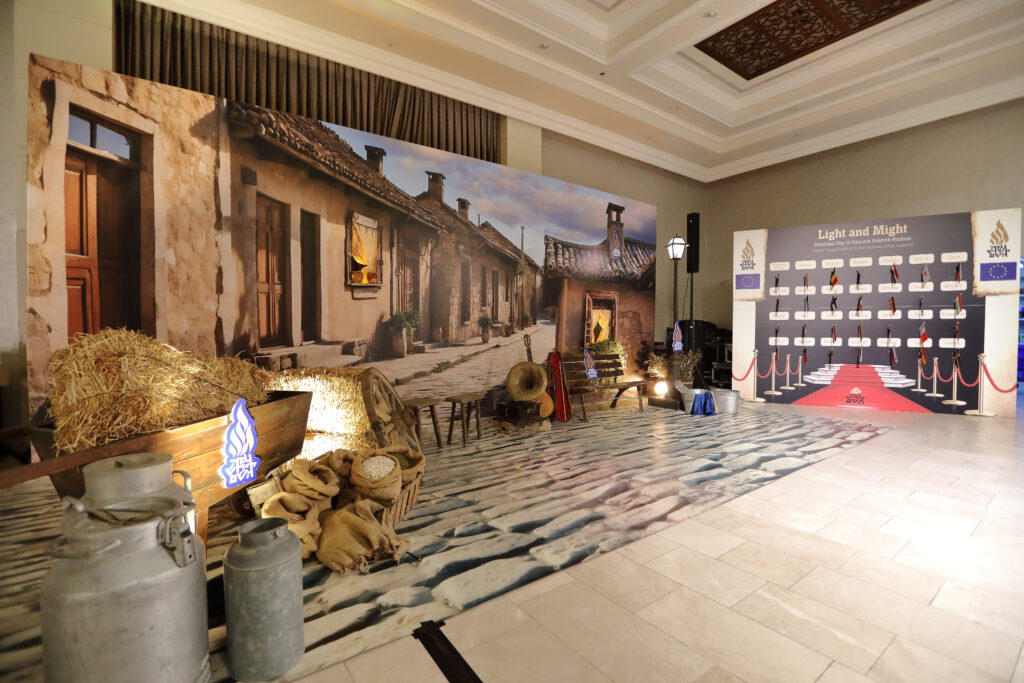
The Heroism of the Jewish Spirit
The entrance to the reception hall was decorated with an exhibition of posters made by ultra-Orthodox students, who expressed in their work the heroism of the Jewish spirit, that was manifested in the lives and deaths of the Holocaust victims, and in the inspiring rebirth of the heroic survivors.
Each ambassador and diplomat was greeted warmly and received a folder especially for him. Ganzach Kiddush Hashem wrote for each of the twenty-seven ambassadors a summary about the bustling Jewish life in the respective country for hundreds of years until the terrible destruction. The articles did not contain meager encyclopedic material of numbers and data, but rather a short and artistic picture in which the unique local Jewish, moving, and pure story is told, the story that will not be told elsewhere, other than in the ultra-Orthodox Ganzach Kiddush Hashem.
To Remember, To Document, and To Demonstrate
The event opened with several blessings. From the screen emerged the image of the man and legend, who is probably the most well-known in the corridors of power all over Europe, the chairman of the board of trustees of Ganzach Kiddush Hashem in Europe, Rabbi Isaac Yehuda Shapira, who in recent years founded the ESJF (European Jewish Cemeteries Initiative) organization and serves as its president, and in this framework, he has been able to save thousands of Jewish cemeteries throughout Europe.
The governor, Rabbi Isaac Yehuda Shapira, a tireless businessman, whose seal is stamped on many institutions of Torah, chessed (kindness), and chasidism, the right hand man of the great Jewish men of the generation, a loyal friend of Ganzach Kiddush Hashem for many years, who now lives in Europe and cannot physically participate in this important event, spoke pleasantly and thoroughly, as is his custom. and left a strong impression on his listeners.
Personal letter from Rabbi Isaac Shapira to the ambassadors
The mayor of Bnei Brak told in his resounding speech about his father z”l, the lone survivor of his family who lived in hiding for three years under a false identity and rebuilt his life in Bnei Brak. No one remained indifferent to the moving family story, especially when he declared: “My eight brothers and sisters and I are the proof of the strength and vitality of the Jewish spirit.” He turned to the diplomats and reminded them of the terrible massacre that took place on Simchat Torah. The murderers did not only search for soldiers. They wanted to kill Jews. The mayor told the guests about the great vision and plan to build a large permanent home for a state-of-the-art Ganzach Kiddush Hashem museum in the BBC business complex, between the BSR towers, in the best place in the city, assigned for this purpose by the municipality, a site that will portray the spirit and faith of European Jewry in the days of the destruction.
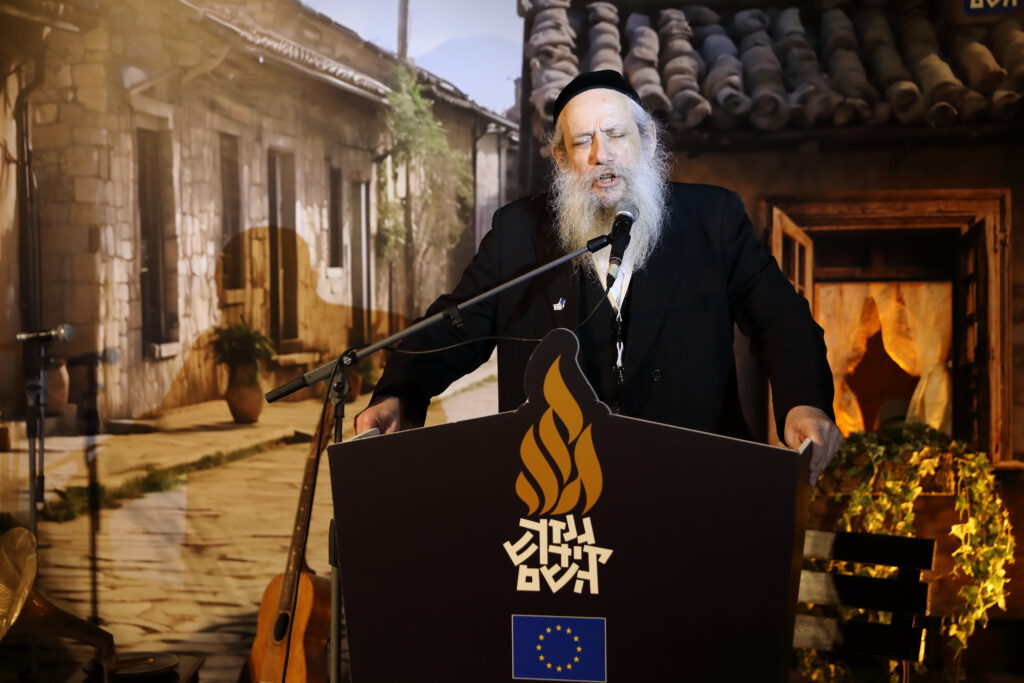
Mayor of Bnei Brak, Rabbi Hanoch Zeibert, speaks
We are committed to ensure that the legacy of the six million does not disappear.
In his speech, Rabbi Zeibert expressed hope that this event will bring in its wake the actualization of the plans. The plan could best be defined in three phrases: to remember, to document, and to demonstrate.
After him, the deputy Minister of Transportation and head of the Authority for Holocaust Survivors, MK Rabbi Uri Maklev, spoke. Rabbi Malkev spoke of the antisemitism that preceded the Holocaust, and the inevitable comparison to the events of October 7th, which also grew on soil saturated with hatred of Israel and antisemitism. The comparison between the Holocaust and October 7th is not in the extent of the murders, since in certain periods, tens of thousands were killed per day in the Holocaust, but the motives are the same, the desire is the same, and the findings are alarming. He noted that copies of the infamous book “Mein Kampf” were found in the homes of terrorists. He compared the historical blood libels with the modern blood libels that accuse Israel of genocide, the accusations of organizations funding antisemities and Israel-haters with billions, and hence pointed out the need to fight rising antisemitism today.
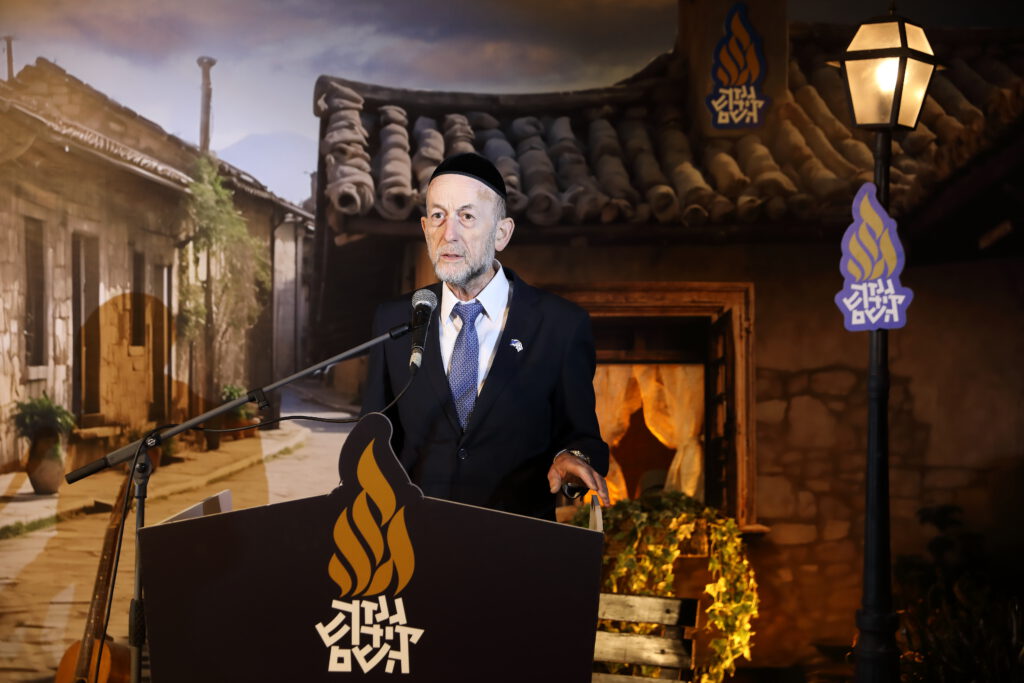
Minister of Knesset and head of the Authority for Holocaust Survivors, Rabbi Uri Maklev, speaks
In his speech, Rabbi Maklev thanked the many distinguished diplomats who came to the event and the European Union for initiating the important meeting, and extolled the uniqueness of the veteran institution, Ganzach Kiddush Hashem, for documenting the heroism of the Jewish spirit. Physical strength, he declared, depends on spiritual strength.
He praised the extraordinary documentation work of Ganzach Kiddush Hashem, which works around the clock to save as much evidence as possible from disappearing. Over the years, many of the Holocaust survivors did not want to talk about what happened to them; this was out of a desire to build happy homes that did not live and breathe the constant “burnt ash” that struck their hearts, but now, in their old age, they have a desire to open up, to “open the box,” so that future generations will know what happened.
The main speech was given by the Ambassador of the European Union to Israel, Mr. Dimiter Tzantchev. In it, he stated that “the Holocaust is a dark stain that will not be erased from the history of our continent, and we as representatives of the European Union countries see it as our sacred duty to ensure that the brutal murder of six million Jewish men, women, and children is never forgotten.”
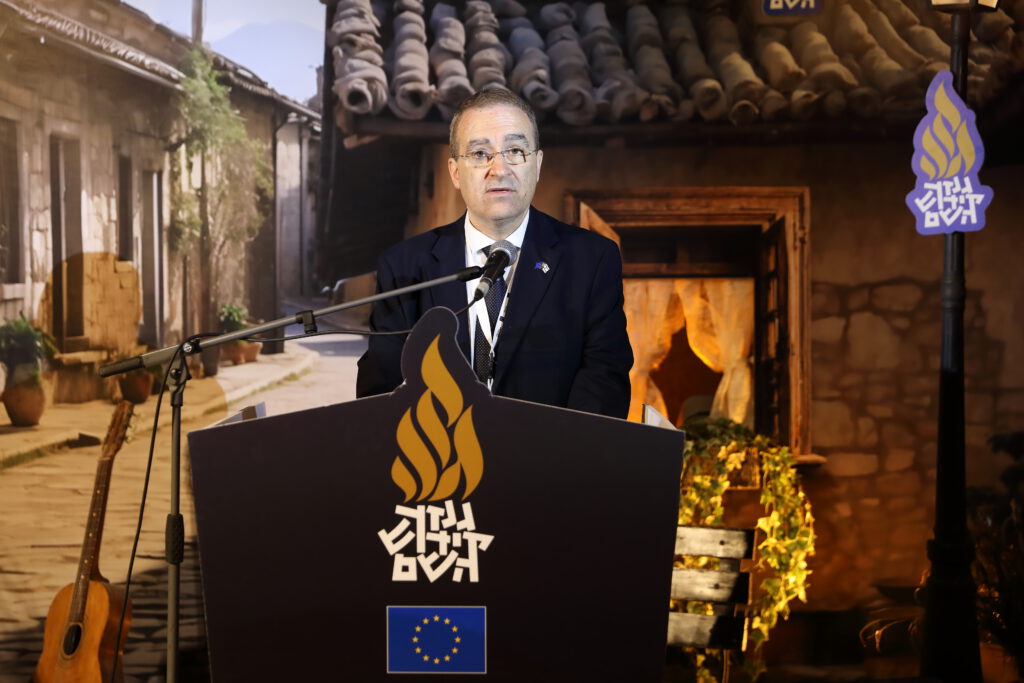
European Union Ambassador, Dimiter Tzantchev, speaks
The ambassador stated that after the horrific events of October 7th, and the wave of antisemitism, which swept Europe and other parts of the world in its wake, the European Union accelerated the implementation of its strategy for combating antisemitism and fostering Jewish life. The ambassador noted that the European Union has increased funding to 5 million Euros to support the protection of Jewish places of worship, schools, and community gatherings. The comprehensive plan includes almost 100 initiatives, 74 of which have already been launched, and their goal is to ensure that Jews in Europe can live their lives safely.
The ambassador continued and spoke emotionally about the past, present, and future. The ambassador, who hails from Bulgaria and whose knowledge of its Jewish history is impressive, even knew that for 13 years, before immigrating to the Land of Israel, the Beit Yosef rabbi lived in Bulgaria (where he founded the Beit Yosef study hall).
Live and Authentic Testimony
On a simple chair sat a special guest, a modest, and pious, elderly woman, who is intelligent and speaks several languages. This is Mrs. Nadia Horowitz, a camp survivor, born in Pabianice, Poland, who lost her entire family in the Holocaust: her father, mother, brothers and sisters, uncles, aunts, and their children. She lost everything, and started all over again. Today she is the mother of a magnificent family of about 200 descendants.
The ambassadors, diplomats, and high-profile guests could not hide their excitement upon hearing the live and authentic testimony.
The guide, Rabbi Arieh Hendler, the head of a yeshiva and a senior lecturer, guided a presentation on “Righteous Among the Nations,” and his words were illustrated through a moving virtual exhibition. The presentation, which combined clips of rare photographs, was screened in a circular hall illuminated by innovative technological means that created an atmosphere combining grandeur and horror. The exhibition shed light on the concept of “Righteous Among the Nations” and expressed the cruelty that the Jews of Europe encountered during the Holocaust on the one hand, and the moral few who came to the aid of their unfortunate Jewish neighbours and helped them to survive hell, on the other hand. The exhibition included testimonies of survivors who told about the way in which they were saved by kind-hearted gentiles. At the end of the lecture, the guide, Rabbi Hendler, surprised the attendees and showed them a small and rare High Holiday machzor (prayerbook) from the Ganzach Kiddush Hashem archive, which was written in secret by a Jew in a ghetto, Rabbi Shlomo Scheiner z”l of Pinczow, whose prayers were written in spectacularly artistic handwriting.
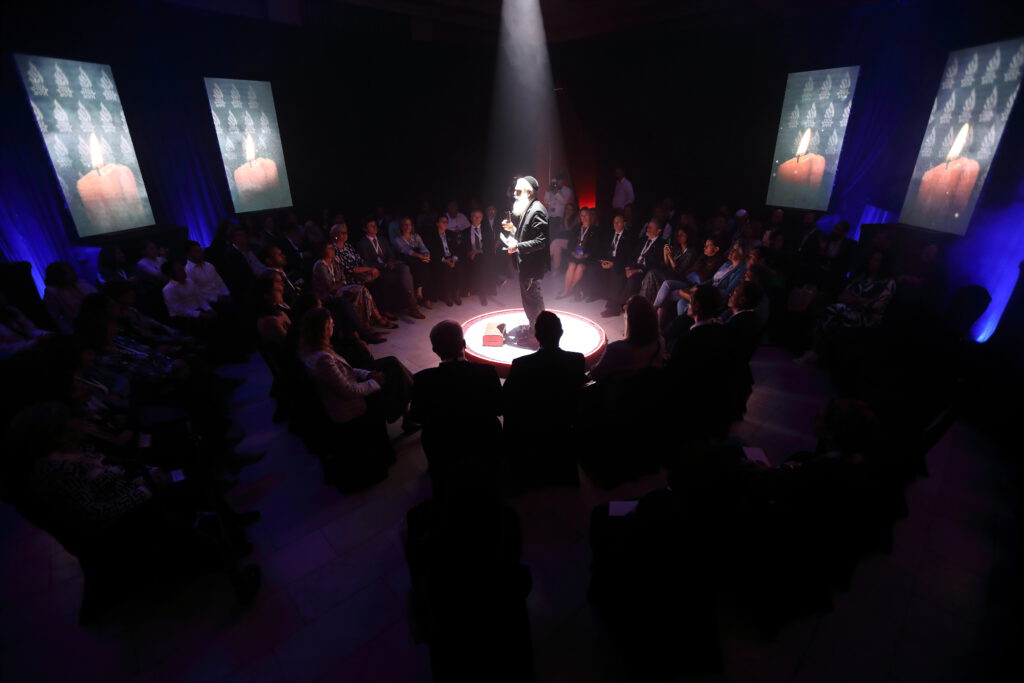
The guide, Rabbi Arieh Hendler, while guiding in the exhibition
Matzpun (The Conscience) – Matzpen (A Compass)
Dozens of ambassadors from all EU countries sat for a full hour and listened to the story presented in a unique and fascinating way. Indeed, in the darkness of the terrible Holocaust, in which most of the peoples of the world were revealed to be cruel, and in the better cases to have closed hearts, there were some bright spots in the darkness; there were gentiles who saved Jews and even risked their lives for Jews, and today we have to show the world that we will never forget them.
The guide, Rabbi Hendler, explained to those present the comparison between the two concepts that in the Hebrew language are expressed by an almost identical word – matzpun (conscience) and matzpen (compass). For, it is not enough that the conscience torments the heart for what has been done; the conscience is supposed to be a compass that directs the future in light of the lessons of the past, and it is the one that guided the Righteous Among the Nations in their actions towards the helpless Jews.
At the end of the presentation, the Holocaust survivor, Mr. Michael Urich, rose to speak. Born in Tarnopol (then in Poland), Mr. Urich now lives in Bnei Brak. He spoke tearfully about the separation from his parents and his double life living in the home of a Catholic who warmly and lovingly took him in. He spoke briefly about the great rift when he, as a boy at the end of the war, returned to the Jewish people, and what he went through in his childhood when he moved with his engineer father and pharmacist mother, to Warsaw in order to make a living. He described the life in the crowded ghetto, the terrible sights that were part of their daily routine, the poverty, and the suffering. In 5702 (1942), his parents moved him to live with a gentile family and thus he lived for several years with the Stachowicz family, who raised him as if he were their own child. Mr. Urich described his experiences in Warsaw and Buchenwald. At the end of his speech, he described the day he parted from Ms. Helena Stachowicz, when Rabbi Wigderowitz, later a rabbi in Mexico, came to take him.
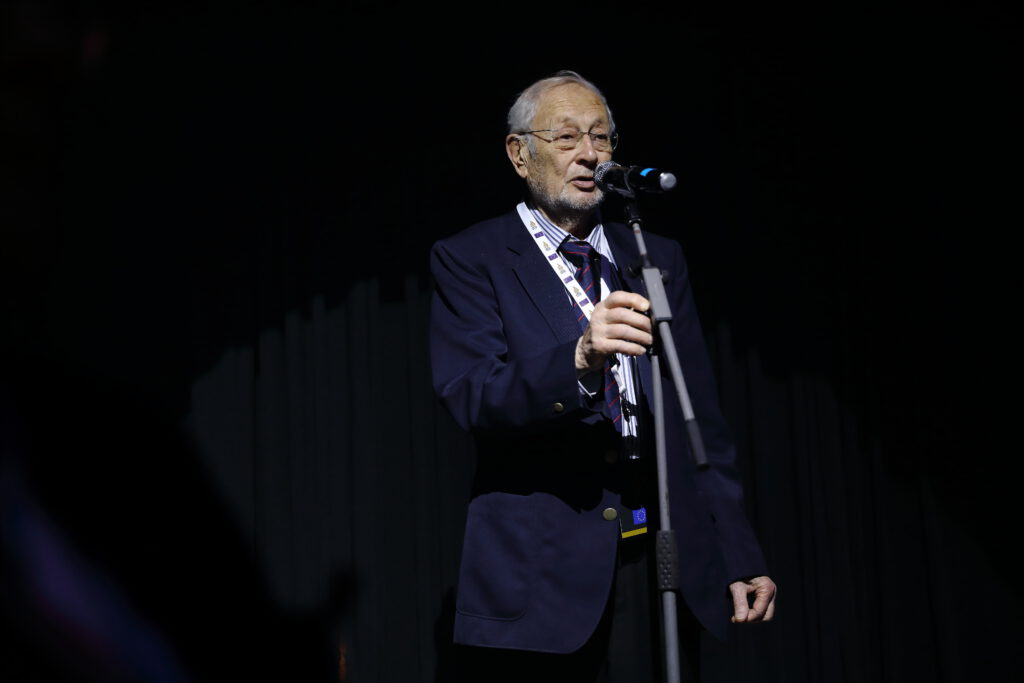
Holocaust survivor, Michael Urich, who was a “hidden child” in Warsaw
A ten-year-old child, who had to decide on his own about his future…
“My adoptive gentile ‘parents’, who were so kind to me, did not object to the rabbi coming to take me, but they wanted me to agree! And I was supposed to answer with something that would determine my future.” He recalled the struggles and mental anguish that made him endlessly sleepless.
Later, Ms. Stachowicz was honoured as a Righteous Among the Nations.
The message that came out of his words was: these thousands of rescuers could not save the millions who were murdered. Even today in the 2000s, courage, morality, and determination are required to stand up to the hatred of the Jews in the world so that such a Holocaust will not happen again, G-d forbid.
From there, through a half-dark corridor, the diplomats passed through Ganzach Kiddush Hashem’s exhibit commemorating the Righteous Among the Nations, and walked towards the conference hall where the main event commemorating Yom HaShoah was held.
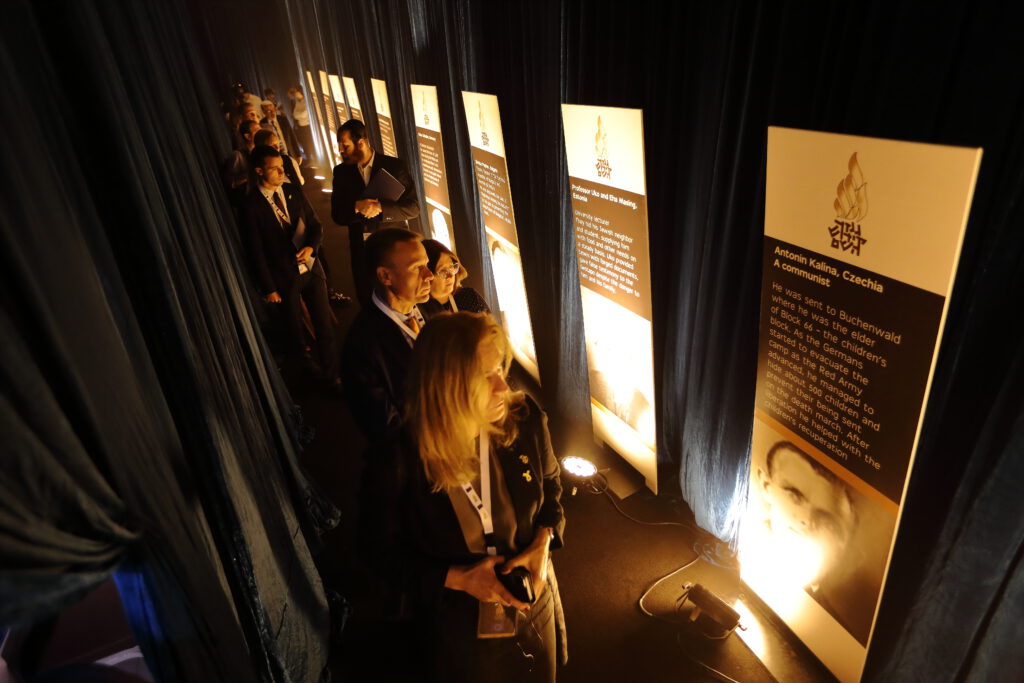
Ambassadors from the European Union member countries tour the exhibition
In the conference hall, the last session of the meeting took place, which was dedicated to the memory of the six million murdered, may G-d avenge their blood. Those currently in need of salvation, the hostages in Gaza, were also mentioned.
Among the guests who described to the diplomats the uniqueness of Ganzach Kiddush Hashem and its significant contribution to the memory of the Holocaust in Israel and the world was Ms. Colette Avital, a Holocaust survivor and chairwoman of “Center Organizations of Holocaust Survivors in Israel.” She spoke about the important role of Ganzach Kiddush Hashem regarding the legacy of the Holocaust memorialization in the ultra-orthodox sector – a society within the State of Israel that for many years did not agree to discuss the issue due to the fear of religious questions that would arise, and today a team of rabbis and educators are sitting on the podium and answering all these disturbing questions.
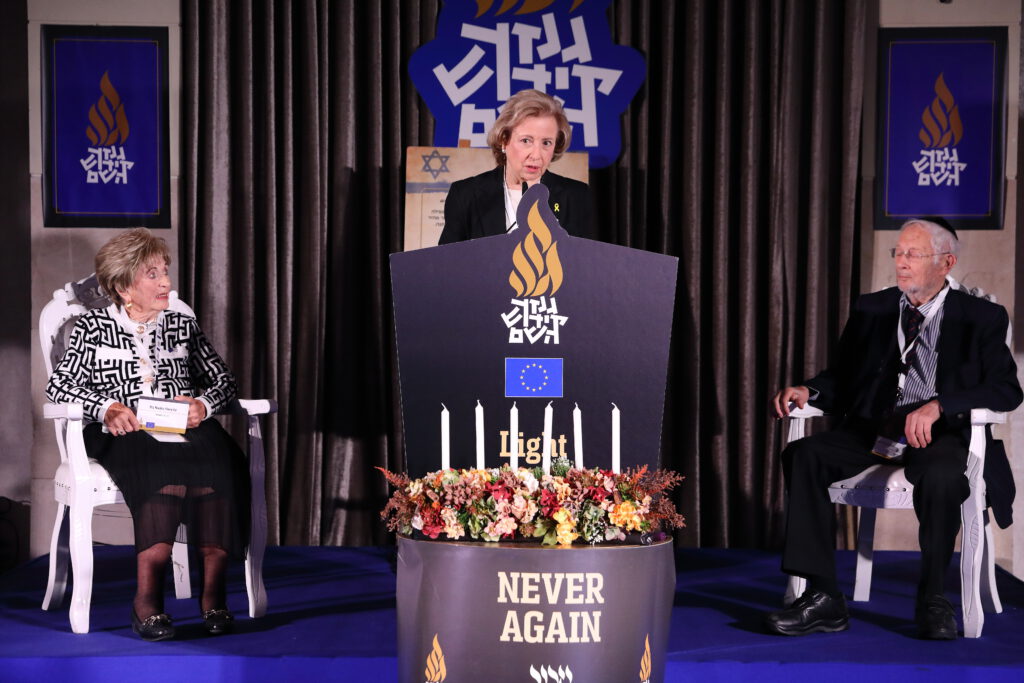
Colette Avital, chairwoman of Center Organizations for Holocaust Survivors in Israel, in a panel with Holocaust survivors Michael Urich and Nadia Horowitz
With great emotion, Rabbi David Skulski, the current president and former director of Ganzach Kiddush Hashem, lit six candles in memory of the six million, and we commemorated his many years of work at the helm of the great institution, passing down the memory of Jewish heroism – the spiritual strength of the Holocaust victims and survivors.
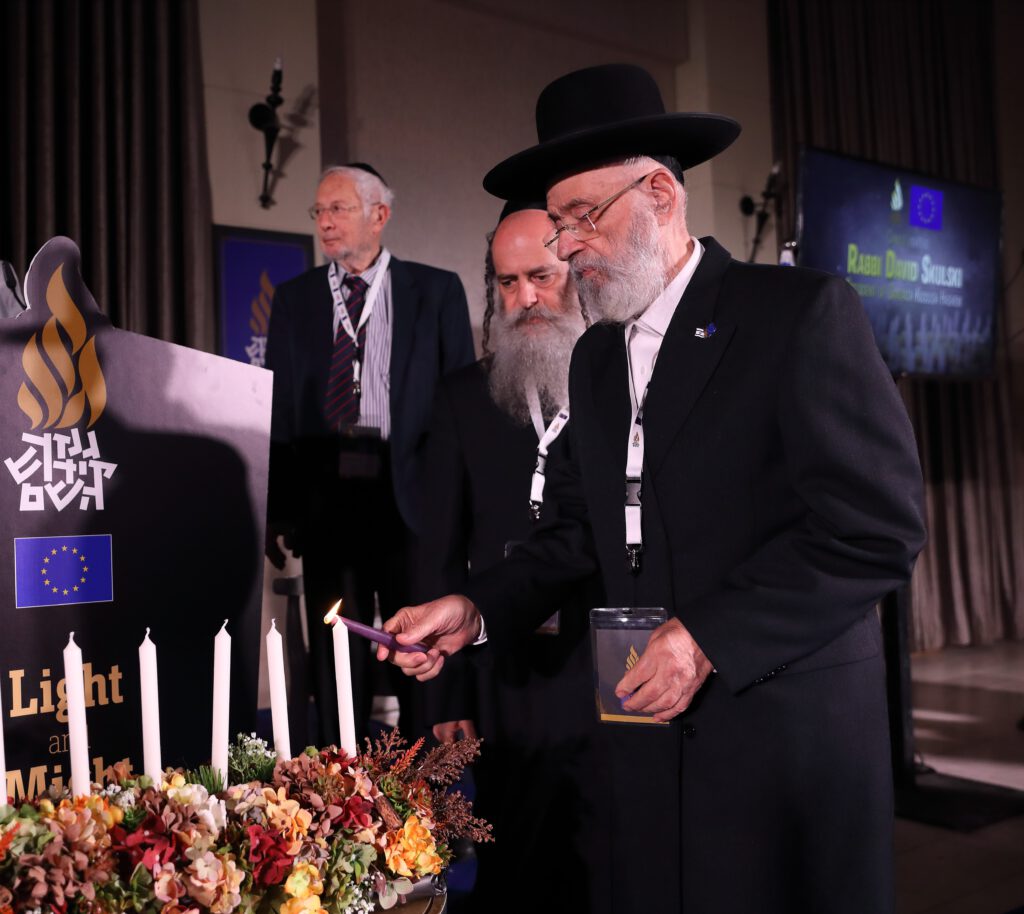
President of Ganzach Kiddush Hashem, Rabbi David Skulski, lighting six candles in memory of the six million Holocaust victims, may G-d avenge their blood
Each of the participants also lit a candle in memory of those who perished and in prayer for the release of the hostages and the end of the war.
Afterwards, the cantor Rabbi Yisrael Adler recited the Kel Maleh Rachamim prayer, which melted hearts. Not an eye was left dry.
Cantor Yisrael Adler reciting the Kel Maleh Rachamim prayer in memory of the Holocaust victims
To close the conference, the COO of Ganzach Kiddush Hashem, Rachel Yud, spoke on behalf of the management:
“We call upon you, Your Excellences, ambassadors, to join hands with us in our sacred and important mission of perpetuating the memory of the Jewish communities that once existed in Europe, which are a glorious part of your countries’ histories. It is a history of rich culture, significant rulings in Jewish law; fascinating literature still used today, poetry, music, and much more of the ancient beauty of Europe. Beauty that someone cut brutally. However, here, in our country, the ultra-Orthodox society effectively preserves it. This preservation, alongside Jewish and universal values, which we instill in the youth, aligns with your struggle against antisemitism. We invite each one of you personally to connect with us, to visit and personally witness our extensive educational activities, and to think together how we can enhance and expand our impact for the benefit of our common important goals.”
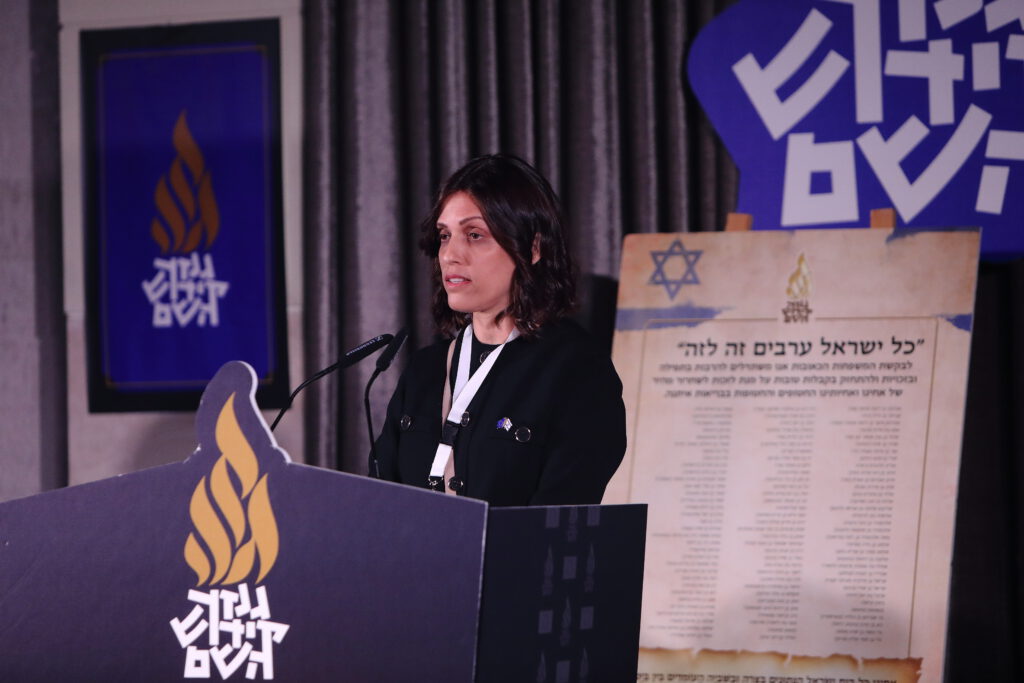
Rachel Yud, COO of Ganzach Kiddush Hashem, speaks
At the end of the gathering, the mayor of Bnei Brak, Rabbi Hanoch Zeibert, was asked what the central message of Ganzach Kiddush Hashem should be to the youth of all denominations who visit it, and to the many more who will, G-d willing, visit the new building. His answer: “The emphasis should be on Jewish spiritual strength. Jews who gave their lives for their principles and did not lose their humanity in the most difficult times. These are the Jews for whom the concept of “exemption” did not exist… (being exempt from certain Jewish laws), but lived with the Master of the World, with the Shulchan Aruch (Code of Jewish Law), in every situation and at every hour. Jews who felt sorry for their suffering friends and were eager to help them while forgetting about their own suffering. And certainly the heroism of the generation of survivors, who hid their grief in their hearts and built a new world with joy, hope, and faith.”
Many will continue to speak about the special visit to the center of the city of Torah and chasidism, Bnei Brak. The gentile ambassadors, who are so far from the ultra-Orthodox way of life, were amazed and moved to discover the consciousness of the Jewish spirit and heroism that is instilled in the Ganzach Kiddush Hashem every day to all sectors of society. Upon leaving the meeting, they met with a group of 12-14-year-old boys from the “Neveh Yisrael” school in Maale Adumim, who had also just left a study day at Ganzach Kiddush Hashem, which dealt with moral dilemmas during crisis. The ambassadors spoke with the boys and were impressed by their feelings and the information they had gleaned after experiencing the educational activities at Ganzach Kiddush Hashem.
There is no doubt that Ganzach Kiddush Hashem brings a different and higher voice to Jewish and humane values and lessons, as they were expressed during the years of the Holocaust. A voice goes from one end of the world to the other end: “Remember what Amalek did to you” in the image of the Nazi beasts, may their named be blotted out.
News coverage of the event:
English:
https://anash.org/ambassadors-diplomats-remember-the-holocaust-at-frum-memorial/
https://www.israelnationalnews.com/news/389579
Hebrew:
https://www.ynet.co.il/judaism/article/hjyyotuz0
https://www.maariv.co.il/breaking-news/Article-1097376
https://www.israelhayom.co.il/judaism/judaism-news/article/15713439
https://www.jdn.co.il/consumer/2195460/
https://ch10.co.il/news/903866/
https://news.walla.co.il/item/3662807
https://www.hidabroot.org/article/1194726
https://www.mivzaklive.co.il/archives/806236
https://www.inn.co.il/news/636817
https://www.kikar.co.il/world-news/sd4cgl
https://www.bhol.co.il/news/1661549
French:














